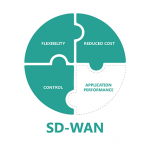Mobile: The driving force behind digital transformation

From retail to manufacturing, the digital transformation is taking the world by storm, and mobile is leading the charge. With mobile affecting everything from corporate processes to the customer experience, it’s important for businesses to understand just how mobile and the digital revolution are bringing big changes.
As productivity increases, so does the need to communicate more quickly. Currently, it takes 50 milliseconds to send a piece of data from one mobile device to another. Impressively, with 5G, that time will be cut to just one millisecond -- now, that’s fast. While operators are projected to spend $1.7 trillion on equipment upgrades between now and 2020 in preparation for the arrival of 5G, the results will be well worth it. By 2025, 5G is expected to reach 2.6 billion subscribers -- or one-in-five mobile connections around the world.
Xbox One reported to integrate with Google Assistant and Alexa

Rumors are swirling that it won’t be long before people could talk to their smart speakers to control aspects of their Xbox One systems. Details are scarce, but here’s what’s known so far.
Microsoft formerly offered voice control functionality for Xbox players through its Kinect accessory. But, once the company discontinued it in 2017, and then quit making Xbox One adapters for the Kinect shortly afterward, gamers became more limited. The Xbox One does have Cortana, but the availability of features that work with Alexa and the Google Assistant could help players do even more with their systems.
Ransomware: As big a threat as the media claims

Ransomware is a very real threat that targets businesses of all sizes and industries. Really any business can be a target. With that being said financial institutions and retail are most at risk given the transactional nature of their business and the number of people that may have access to a terminal or computer at any given point in time.
The first thing that an organization needs to do is recognize that they are a target for ransomware just like any other company. Next, they need to ensure that they have the proper tools anti-virus/anti-malware installed on all computer systems to detect and defend against ransomware attacks. Of course, after this comes ensuring that the anti-virus/anti-malware software is kept up-to-date to ensure that the signature and traffic detection patterns are updated. It is critical that businesses have some sort of ransomware defense plan in place.
Three steps to avoid being the next victim of an insider data breach

You may be wondering why I’ve chosen to specifically focus on "insider" breaches. The answer is simple, virtually every breach of any consequence has been the result of abuse, misuse, or hijacking of legitimate user credentials. More often than not the credential in question is an administrative login such as root (aka Superuser), database administrator, system administrator, or any of the myriad of admin accounts that proliferate every business system that processes and stores sensitive data.
Let me start by providing you with some background.
VR is changing user experience design

Virtual reality has skyrocketed in popularity in just a few short years. Ten years ago, VR tech simply wasn’t there, and if it was, the hardware was prohibitively expensive.
Now, your smartphone can act as a VR headset. With Google Cardboard, a smartphone with VR capabilities, and a 3D printer, you can gain access to VR tech for almost no cost whatsoever.
An inside look at Google’s hiring and onboarding processes

As one of the most iconic IT companies in the world, Google is, unsurprisingly, a popular place to work. Reports have indicated the company gets about one million resumes every single year. Google needs to have a solid system in place to narrow down its applicant pools and choose the best people for each open position. What exactly does this process look like, and how can other IT employers learn from it?
Let’s take a closer look at Google’s hiring, onboarding, and background check processes to find the answer.
A lesson in IT from M&S -- adapting to a digital-first world

The UK retail sector is in a state of flux, with well-known businesses like Mothercare, Debenhams and New Look closing down stores and cutting jobs, while high-street stalwarts like House of Fraser and Marks & Spencer are struggling to keep their head above water and their income out of the red.
One of those retailers, Marks & Spencer (M&S), has turned to revitalizing its IT department in a bid to remain competitive and focus on returning profits to their previous highs. This new Technology Transformation Programme saw 250 roles move over to Tata Consulting in March, but remain based in M&S’ Middlesex headquarters.
After eight years in development, Camera+2 is finally released

When you’re on a vacation, you want to make sure you can get the best possible photos from your environment. This meant (and still does for many) dragging around a huge DSLR camera with telephoto lens all day.
Problem is, apart from the weight, dragging a DSLR can attract all the wrong attention. You look like a semi-professional commercial photographer on an unauthorized shoot and, travel to places such as Miami and Los Angeles, and there are lots of locations where you can’t take your sizeable camera.
EaseUS releases free ToDo Backup 11 with optimized backup

How many people backup their data? A decreasing number. The new standard is to upload our data to the cloud, storing our most important files and documents in a remote location and then synchronizing those files across our various devices.
Backing up our data is old-school, right? There’s certainly an element of truth to this. These days, along with the cloud, if you have a password manager, retrieving your important data now takes minutes, not hours. Gone are the days when your system would crash and you’d have to start recovering your entire drive to get access to your system.
Why SD-WAN is the right way to enable a digital business

An IDC survey of mid-market enterprises found that that enterprises are embracing SD-WAN-based infrastructure services. The survey identified that drivers include better automation, bandwidth optimization, consistent application security and self-provisioning.
IDC Network Infrastructure vice president Rohit Mehra noted that the enterprise WAN is rapidly being "re-architected to cost-effectively deliver new, secure capabilities" and that adapting SD-WAN is a "key ingredient for success." Good advice, no doubt, but let’s dig a little deeper. Here are the reasons why SD-WAN is the right way to meet your digital business needs today -- and tomorrow.
AgileBits releases all-new 1Password 7 for Mac, Windows version to follow

How do you store your passwords? You’ll be surprised. Some people use the same memorable pass for most websites, but if this is compromised it offers the fraudster access to every site where you used the single login.
Other people simply write down their passwords. To be fair, if you can trust the people in your household, there’s no problem with this, but how do you access your website logins on the road? Do you take your notepad with you, containing every single login and, no doubt, your bank password?
Don't be phooled: 10 phishing techniques to look out for

In 2016, American businesses suffered half a billion dollars a year in losses from phishing attacks with the average cost at $1.6 million each. These numbers are alarming evidence that just one click can cause significant financial and reputational damage to your brand. And since studies show that a staggering 30 percent of phishing emails get opened, it’s no wonder that they consistently rank as the top cyberattack vector.
Despite being one of the oldest cyberattacks in the book, phishing remains so popular because it’s a highly effective means of exploiting the weakest link in the cybersecurity chain: humans. To make matters worse, hackers have become much more sophisticated in their techniques: no more poorly written, typo-ridden Viagra spam emails and unclaimed heritage scams. Phishing attacks are now highly targeted, dynamic and "hypermorphic," making them increasingly difficult for both humans and machines to detect.
New microchipping method crams more circuits, power into them

Technology progresses quickly. In large part, that’s due to semiconductors, which power everything from computers to toasters.
As semiconducting components become more advanced, they get smaller and more powerful. This, in turn, enables electronic products to become smaller, more powerful and more cost-effective. One company, which has long been a leader in the semiconductor business, recently introduced a unique machine that takes microprocessor production to the next level.
Workplace challenges for enterprise wearables: Anatomy and fashion

While the success of Apple Watch has attracted the most attention when it comes to enterprise wearables in the workplace, the market is beginning to split into battles for the wrist (and borrowing from Neil Cybart), the eyes (e.g. Google Glass) and the ears (e.g. AirPods). Not to mention wearables for the body -- smart garments and (God forbid) implantables (Now, apparently, a word. Though if someone in my company tells me I need to implant something for my job, they will have my resignation before they finish the request).
But the adoption of such technology comes with a practical limitation -- we each have only so many wrists and assorted body parts. And let’s not discount the fact people will naturally resist adorning themselves with devices throughout the workday. Nobody wants to walk around the office looking like they’ve just been assimilated by the borg.
Workplace Augmented Reality: When will we see more enterprise adoption of AR?

First, let’s clarify the difference between Augmented Reality (AR) and Virtual Reality (VR). Virtual Reality (VR) blocks out the real world and immerses the user in a digital experience. Augmented Reality (AR) adds a layer of interactive digital elements on top of the real world. Or in simpler terms, AR can be defined as a technology which overlays a computer-generated image on a user’s view of the real world. The question is: when will we begin to see more Enterprise adoption of AR?
Companies are eager to jump on the AR bandwagon but are still unclear how to best use AR to drive sales around their product, improve efficiencies for their operations. Additional unknowns include how much it will cost to enhance the B2C/B2B experience and when companies could expect to see a return on their investment.
BetaNews, your source for breaking tech news, reviews, and in-depth reporting since 1998.
© 1998-2025 BetaNews, Inc. All Rights Reserved. About Us - Privacy Policy - Cookie Policy - Sitemap.
